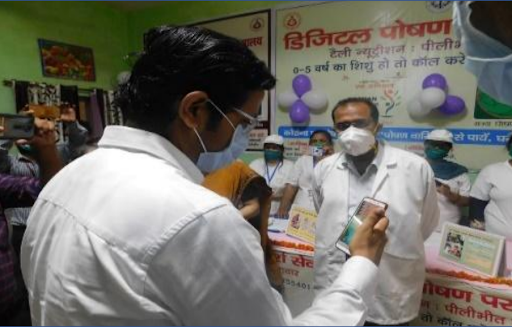
Shri Narendra Modi
Hon'ble Prime Minister of India

जिला सुशासन सूचकांक 2022
District Good Governance Index 2022



जिला सुशासन सूचकांक 2022
District Good Governance Index 2022


During the period of global pandemic, the healthcare system all over the globe collapsed. Besides, due to the pandemic induced lockdown, when the schools and anganwadi centres in the country were closed, it became very difficult to maintain the nutrition status and services in community. The health of each society indicates the future economic status of that society. A healthy society paves the way for a strong economy. Healthy and well-educated children will help in the upliftment of the economic development of the country and society. Hence, tele-nutrition became a better alternative in bridging the gap between malnourished families and nutrition counsellors.
More than 70 % of the state's population lives in rural areas, which lacks in awareness. Malnutrition needs to be combatted using curative methods as well as adopt preventive measures, like social awareness and good nutrition habits. This calls for preparing a guideline to run the initiatives effectively. In these areas, nutrition counselling is provided to the families by establishing direct communication through the Tele Nutrition Centre, which can be made aware to all sections of the community by implementing it.
Thus, to combat the concerns regarding nutrition in the district of Pilibhit, the District Collector started an innovative centre in the District Hospital of Pilibhit. During the pandemic, parents were unwilling to bring their malnourished children to the Nutrition Rehabilitation Centre (NRC) due to fear of COVID-19. Thus, the existence of “Tele-Nutrition Centre” enabled everyone to remain in the security of their homes, while regularly communicating with counsellors through virtual channels to avail appropriate guidance.
The purpose of this innovative experiment was to provide nutritional counselling as well as regular follow-ups through phone calls to all the families of malnourished children. The case study evaluates how the Tele-Nutrition Centre is making a very positive, effective and sustainable contribution to the communities of Pilibhit.
The Tele-Nutrition Centre was established in the district hospital by the Bal Vikas Seva Evam Pustahar Vibhag or the Department of Child Development Services that was constituted to operate the Integrated Child Development Scheme (ICDS). The centre is run by a team of eight named as the “Nutrition Warrior”. These nutrition counsellors are guided by the nutrition specialist of the Nutrition Rehabilitation Centre (NRC), Paliwal. Necessary advices are given to the families of malnourished children according to their age, weight, length and nutritional status. Follow-up sessions are placed a week apart from the previous session. The centre is operated only by means of available resources of associated departments. No additional expenditure was involved in starting and sustaining this service.

Fig.1.1 The District Magistrate (DM) Mr Pulkit Khare Inaugurating the Tele-Nutrition Centre.
The telephone number for availing this service was publicized widely throughout the district. Towards this cause, the commendable contributions of many social organizations and Anganwadi workers yielded great success. Various media, like newspapers, intervened in this matter with much social responsibility through free-of-cost broadcasts. By disseminating correct information without any cost, more people could become beneficiaries.

Fig.1.2 The Tele-Nutrition Centre
Growth monitoring was conducted at all the 1,960 AWCs in the district and it assessed the nutritional levels of 180,514 children in the age group of 0-5 years. Till date, 2,297 malnourished children benefited from this service. Counselling was given to parents in order to educate them about preparing nutritious food with whatever that is available in the household. Along with this, parents were also made aware of the appropriate quantity of food required at prescribed intervals based on their age and nutritional needs. The details of every malnourished child are maintained separately. Hence, within two months, counselling benefits were availed by 978 families. Through video calls, the weekly weights and heights of children are recorded. The weekly follow-ups thus helped to improve the nutritional status of the children.

Fig.1.3 The DM Interacting with the Stakeholders.
In 2020, during the nutrition month of September, 987 children from underprivileged (Lal Shreni) families received nutrition counselling through the Tele-Nutrition Centre. Consequently, 394 children were converted to yellow category and 285 children to green category. Thus, in two months, a total of 679 children were brought out of the malnutrition category. This is an indicator for the fact that the health and nutrition level of children in the NRC were improved during the pandemic without physical consultation. Apart from this, a target of transforming the 16,449 malnourished children of the district, grouped in red and yellow categories to healthy and nourished was set for the coming months.
Information related to nutritious food, nutritional level and length-weight ratio reached even the most remotely located beneficiaries. Hence, with the Tele Nutrition service established in the district, all sections of the society have access to effective solutions to tackle malnutrition in their children. Because of regular guidance and follow-ups, children were ensured to be well-fed and healthy.
Hence, the Tele-Nutrition initiative laid the foundation for healthy children and through them, a healthier society because they are the future of the society.